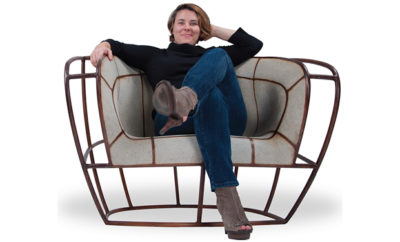 Photography by Thomas Loff
Photography by Thomas Loff
Feature
East Hampton aplomb
New York collectors Joel and Helen Portugal reveal an affinity for mid-century design
The built landscape of Long Island’s Hamptons is dominated by late eighteenth- and nineteenth-century shingle style houses and the very latest in contemporary residences. But Joel and Helen Portugal opted for a twentieth-century modernist aesthetic when it came time to outfit a new summer and weekend retreat in East Hampton. This is in marked contrast to the couple’s Upper East Side apartment, which showcases art deco from Émile-Jacques Ruhlmann to Jean Dunand and Edgar Brandt. “Art deco particularly suits a Manhattan environment as the city is filled with so many major buildings from that period, such as Rockefeller Center and the Eldorado apartment house,” says Joel Portugal, who founded a corporate-identity consulting firm with clients ranging from Texaco to Citibank. “We did not set out to collect modernist furniture for our house in the country but rather to find furnishings and art we could live with while relaxing,” he says. “We had been drawn to design examples from the fifties and sixties such as Prouvé and Nakashima for our former summer home in Southampton and wanted to further emphasize that specialty in our new house.”
A ten-year-old residence in the modernist style gave them the opportunity to do so. To complete the setting the couple turned to East Hampton architectural consultant Sandra Brauer, who had executed a string of projects in the Hamptons that draw on the modernist aesthetic, and Amy Lau, who heads up Amy Lau Design in the West Chelsea arts district. Brauer enlarged the footprint of the house from twenty-nine hundred square feet to thirty-four hundred, extending the kitchen and adding a guest suite.
For the interiors, Helen Portugal says, “with her knowledge of and sensitivity for mid-century design, Amy understood our needs on multiple levels.” Indeed, Lau, who started her firm in 2001, is no stranger to the fine points of mid-century art and design. After completing Sotheby’s graduate program in fine and decorative arts, she became design director at New York’s Lin-Weinberg Gallery, which specialized in modernist furniture. She subsequently co-founded the Design Miami fair in 2005 and served as co-chair of the Design Council of the Museum of Arts and Design. In addition to Lau’s extensive retail and residential commissions, she acts as an advisor to private collectors of twentieth-century decorative arts. “I first met Joel and Helen sixteen years ago while at Lin-Weinberg, when I introduced them to the work of such influential Swedish mid-century ceramists as Gunnar Nylund and Stig Lindberg,” Lau says. “Stoneware by those masters in specialized glazes from neutral to brilliant shades of red are really unique small works of art. Helen and Joel’s penchant for design from the fifties and sixties complements their ceramics collection to perfection.”
Lau says that overall she “kept to a neutral palette to make the rooms appear larger and to emphasize their modernist furnishings.” “But Amy went far beyond paint chips and fabrics to sourcing pivotal design examples,” Helen says. Dominating the foyer is a Jean Prouvé and Charlotte Perriand oak and enameled-metal shelving unit from the 1950s. Typically, such Prouvé-Perriand pieces are in a palette of black, yellow, and red, but this one is heightened by blue. “We purchased it from Tony DeLorenzo who was enormously helpful,” Helen Portugal says. DeLorenzo Gallery director Adriana Friedman adds, “We have never seen one in this exact shade of blue—it was probably a commission for a private residence.” Placed opposite the shelving is a George Nelson 1946 Platform bench for Herman Miller. “Everything works together because they are all icons of their period. Since Joel was in graphics, he understood from the beginning the importance of integrating balance in design, color, and line,” Lau says.
In the living room Lau reworked a brick fireplace wall by covering it in white stucco and building bookcases on either side, “so it’s the focus point to the room.” Over the fireplace is a 1940 Erik Nitsche lithograph for General Dynamics in brilliant red and yellow that provides a shot of color. The contemporary white ceiling fixtures by David Weeks give a Calderesque touch. Flanking the fireplace are Vladimir Kagan’s 1960 Swivel armchair number 524 and ottoman in a shade of citron and a classic Osvaldo Borsani P40 lounge chair designed in 1955 for the Alitalia lounge in Rome’s Fiumicino-Leonardo da Vinci International Airport. Lau had the Borsani chair reupholstered in Tecno fabric in the original poppy red. On one wall hangs a George Nakashima walnut cabinet. The coffee table by Greta Magnusson Grossman for Glenn of California adds another nod to the 1950s and the small triangular Alexander Girard mirrored table, to the 1960s. The contemporary sofa is backed by Judy Ross needlepoint pillows with a design in homage to Sonia Delaunay.
The living room opens into the dining area, which contains a contemporary Mira Nakashima walnut table surrounded by eight chairs in the vein of mid-century Australian designer Allan Gould’s Compass chairs.
Helen Portugal refers to the master bedroom as “our Nakashima room.” The bedside tables, chest of drawers, and a small table, all in walnut, are George Nakashima’s designs; the bench at the foot of the bed is a 1950 design by Jens Risom for Dual Modern. “We wanted two of a particular Pierre Paulin chair for the bedroom, but there was only one,” she says, referring to Paulin’s 1965 F545 Tulip chair for Artifort. “Within forty-eight hours, Amy had found a matching one in Paris.”
That sort of expertise from Lau and their taste have helped the Portugals fill their new country house with exemplars of postwar and modern design.













